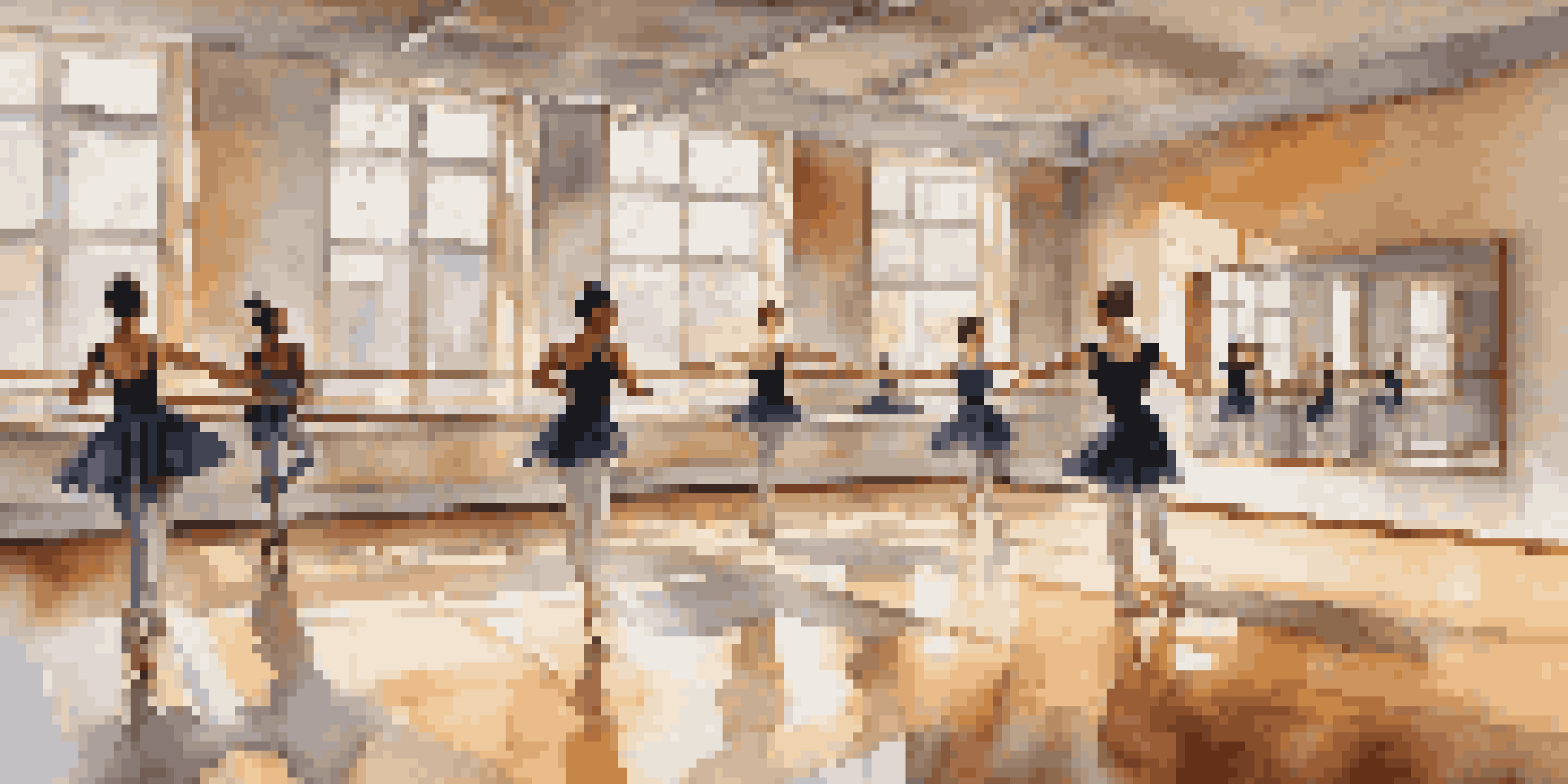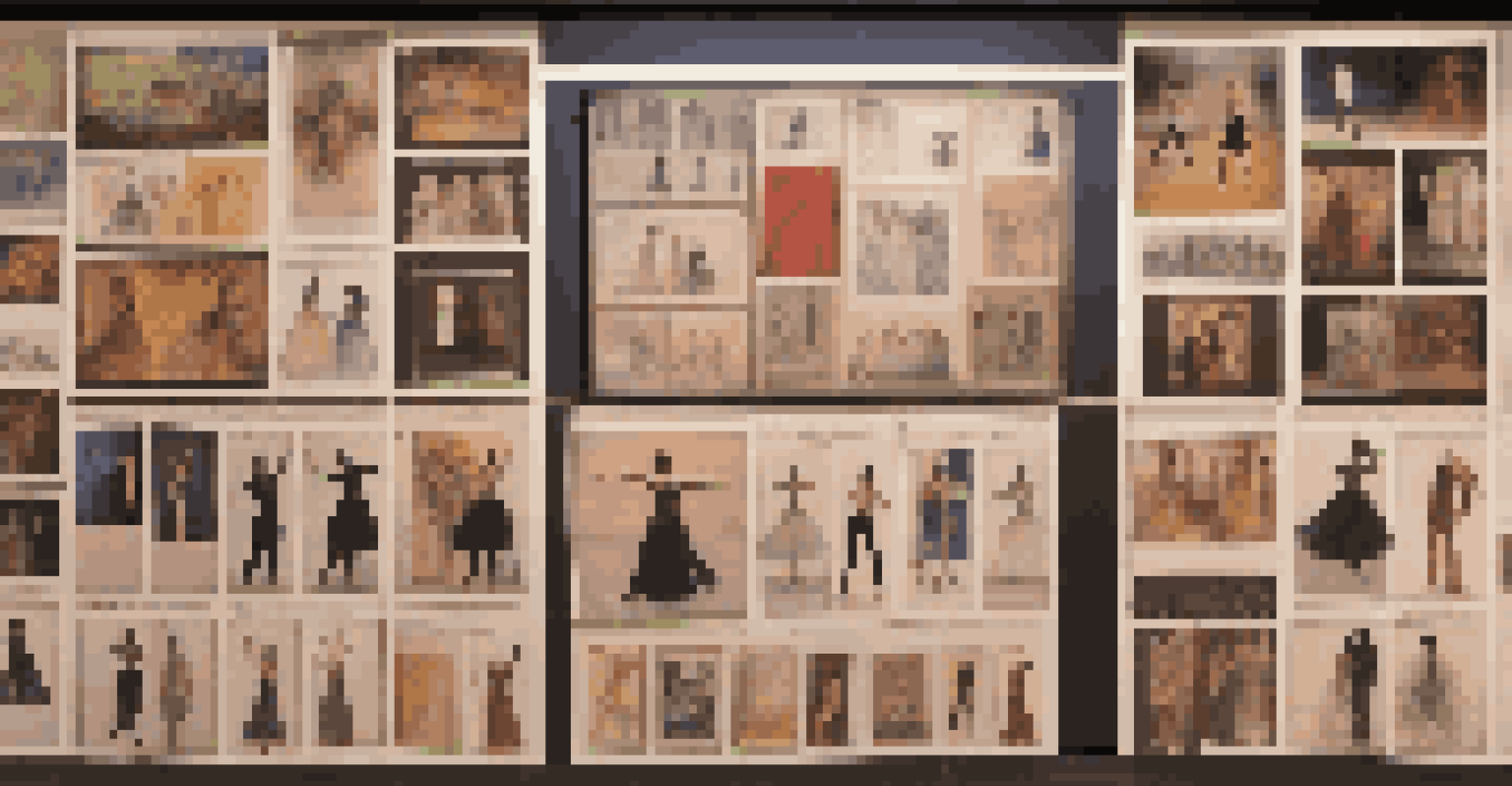Digital Archives: Preserving Dance History for Future Generations

The Importance of Dance History in Cultural Heritage
Dance is more than just movement; it's a reflection of cultural identity, social change, and artistic expression. Just like a cherished family recipe, each dance form carries a unique story that connects generations. By preserving dance history, we ensure that the narratives behind these movements continue to inspire future artists and audiences alike.
Dance is the hidden language of the soul.
Understanding the evolution of dance helps us appreciate its significance in various societal contexts. For instance, the transition from traditional ballet to contemporary forms illustrates shifts in artistic expression and cultural values. This historical knowledge enriches our experience as spectators and participants in the art of dance.
Moreover, dance history serves as a valuable resource for educators and choreographers. By studying past styles and techniques, they can innovate and create new works that pay homage to their roots. In this way, preserving dance history becomes a vital part of fostering creativity and artistic development.
How Digital Archives Are Transforming Preservation
Digital archives are revolutionizing the way we preserve dance history. These platforms allow for the collection, storage, and sharing of dance performances, interviews, and related memorabilia in a way that was previously unimaginable. With just a few clicks, users can access a treasure trove of information that spans decades or even centuries.

The use of high-quality video recordings and digital documentation ensures that the essence of a performance is captured for future generations. Imagine watching a performance from the 1920s in stunning clarity, experiencing the emotions and artistry as if it were happening live. This level of access transforms how we engage with and understand dance history.
Dance History Reflects Cultural Identity
Preserving dance history connects generations and showcases the cultural narratives behind various dance forms.
Furthermore, digital archives encourage collaboration among scholars, dancers, and enthusiasts worldwide. By sharing resources, ideas, and experiences, the dance community can create a more comprehensive understanding of its history. This interconnectedness fosters a sense of belonging and collective memory that transcends geographical boundaries.
Key Examples of Successful Digital Dance Archives
Several notable digital archives have emerged, showcasing the potential of this preservation method. The Dance Heritage Coalition, for instance, is dedicated to preserving American dance history through various multimedia resources. Their website offers access to a wide range of materials, including video performances and scholarly articles, making it a vital hub for dance enthusiasts.
The dance is a poem of which each movement is a word.
Another excellent example is the International Dance Council's online archive, which features contributions from dancers and choreographers around the globe. This platform not only highlights diverse dance traditions but also fosters cross-cultural dialogue and understanding. By showcasing various styles, it celebrates the richness of dance as a global art form.
These archives serve as a testament to the importance of collaboration between artists, historians, and technologists. Their success demonstrates that merging digital innovation with traditional preservation methods can yield significant results for the dance community.
Challenges in Creating Digital Archives for Dance
While digital archives offer immense potential, they also face several challenges. One of the most significant hurdles is the need for funding to create and maintain these resources. Without adequate financial support, many projects struggle to keep up with technological advancements or to ensure the longevity of their collections.
Furthermore, the ephemeral nature of dance poses unique difficulties in documentation. Unlike static art forms, dance is performed and then often lost in time. Capturing the nuances of movement, emotion, and context requires skilled videographers and editors who can translate a live experience into a digital format.
Digital Archives Enhance Preservation
Digital platforms revolutionize the way dance history is preserved and shared, making it accessible to a global audience.
Lastly, there is the issue of accessibility. While digital archives can reach a broad audience, they still rely on access to technology and the internet. Ensuring that these valuable resources are available to a diverse audience remains a crucial consideration for those involved in digital archiving.
The Role of Technology in Dance Documentation
Technology plays a pivotal role in documenting dance performances. With advancements in video recording, editing, and archiving software, choreographers and dancers can create high-quality representations of their work. This not only preserves the performance but also allows for greater analysis and study of dance techniques.
For example, motion capture technology can provide insights into the biomechanics of movement, offering dancers new ways to refine their technique. By analyzing these digital representations, dancers can push the boundaries of their art form and explore new creative avenues. It’s like having a personal coach that helps them understand their body in motion.
In addition, virtual reality (VR) is emerging as an innovative tool for experiencing dance. Imagine stepping into a VR environment where you can watch a performance from different angles or even interact with the dancers. This immersive experience could transform our understanding and appreciation of dance, making it more accessible and engaging for audiences around the world.
Education and Training for Future Dance Archivists
As the field of digital archiving continues to grow, so does the need for trained professionals who specialize in dance preservation. Educational institutions are beginning to recognize this demand, offering programs that combine dance studies with archival practices. This interdisciplinary approach equips students with the skills necessary to navigate both the artistry of dance and the technical aspects of digital archiving.
Courses in digital media, preservation techniques, and dance history prepare future archivists to tackle the unique challenges of their field. By understanding the intricacies of dance performance, they can better document and preserve these fleeting moments for future generations. It’s like training a translator who understands both the language of movement and the language of technology.
Future Needs Trained Dance Archivists
The growth of digital archiving in dance necessitates education and training for professionals to effectively document and preserve this art form.
Moreover, mentorship opportunities within established archives can provide invaluable hands-on experience. Aspiring archivists can learn from seasoned professionals, gaining insights into best practices and innovative strategies. This collaborative environment fosters a new generation of dance historians dedicated to preserving the art form.
The Future of Digital Archives in Dance Preservation
Looking ahead, the future of digital archives in dance preservation is promising yet requires ongoing commitment. As technology continues to advance, we can expect even more innovative ways to capture and share dance history. This evolution will likely enhance our understanding of dance, making it accessible to a wider audience.
Furthermore, as more organizations recognize the importance of preserving dance history, we may see an increase in collaborative efforts across institutions. By pooling resources and expertise, these partnerships can create more comprehensive archives that encompass various dance styles and traditions. Imagine a global repository of dance that showcases the beauty and diversity of this art form.

Ultimately, the preservation of dance history through digital archives is essential for future generations. By investing in these resources today, we ensure that the stories, movements, and emotions of dance remain alive and relevant. It’s a legacy worth preserving, reminding us of our shared humanity through the art of movement.